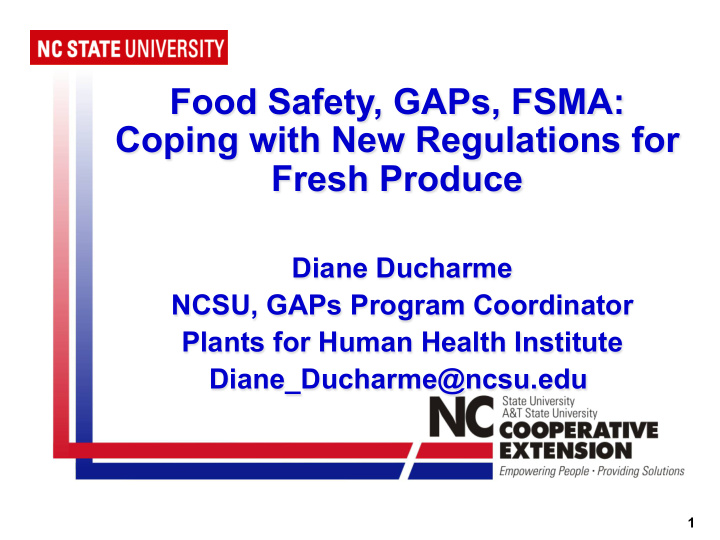



Food Safety, GAPs, FSMA: Coping with New Regulations for Fresh Produce Diane Ducharme NCSU, GAPs Program Coordinator Plants for Human Health Institute Diane_Ducharme@ncsu.edu 1
topics • NC’s Model for Education • Identifying Microbial Risks & Remediation Steps • GAPs audit • FSMA • Resources 2
NC’s Model • NC Fresh Produce Safety Task Force • Team Approach • Tiered-educational initiative – Agent-delivery – Specialist-delivery 3
North Carolina Fresh Produce Safety Task Force • Purpose: to minimizes food safety risks and enhances the economic competitiveness of North Carolina ’ s fresh produce industry. • Goal: To ensure that North Carolina has a competitive, vibrant and safe fresh produce industry supported through the research, teaching and outreach programs of N.C. State University, N.C. A&T State University, North Carolina Department of Agriculture and Consumer Services, Farm Bureau and industry groups.
Unique Partnership • Individual Growers • Fresh Produce Brokers/Distributors • Commodity Groups- Carolina Farm Stewardship Assoc. and others • N.C. State University • N.C. A&T State University • North Carolina Department of Agriculture and Consumer Services – Marketing and Food & Drug Divisions • NC Farm Bureau • Carolina Farm Stewardship Association • United States Food and Drug Administration (FDA)
6 Working Groups 6 • Education • Research • Industry and Policy Relationships • Networking and Communication • Small Farms • Management Sept. 2010
Training Aids in the form of Team 7
Testing your KNOWLEDGE Pre & Post tests developed • What are you coming in with? • Use of real-time technology 8
Break out activities Top Three Words for … . • “Produce Safety” • Number off (1,2,3) • Break into groups • Present to group 9
http://www.cnn.com/2012/05/03/health/listeria-outbreak-investigation/ index.html 10
• fresh produce safety tiered educational curriculum (Tier 1-3) • communication toolkit for agents • on-line curriculum participant tracking • certificate of attendance issuance • searchable database for grower’s marketing tool • social media tools (Website, Blog, news releases, interviews) • growers tool kits • fresh produce safety plan template Highlights of • risk and liability (2) extension information Accomplishments sheets • impacts (1) and case studies (3) documents; • direct market display risk checklist • needs assessments from agents and growers • videos including The Produce Lady, risk & liability, educational mock audits • eight bilingual worker trainings videos (YouTube)
Farmers Market Curriculum Tier 3 Small Farms Focus Tier 2 - Traceability and Risk Mgmt Tier 1- Basic Level
Basic Training - Every Grower Should Know • Module 1: Fresh Produce Safety Introduction • Module 2: GAPs Field Practices • Module 3: Packing Facility Sanitation • Module 4: Health and Hygiene • Module 5: Animals, Animal Byproducts, Biosolids &Site Selection • Module 6: Water Quality
Advanced Training - Risk Identification and Management • Module 7 : The 3 Ts: Transportation, Traceback and Traceforward • Module 8 : Managing Liability and Risk • Module 9: Dealing with Controversies and Crises: Working with News Media • Case Study: Bagged Spinach Outbreak • Validation Techniques ( hands-on) • SSOP, SOP, and food safety plan
Food GOOD FARMER ’ S MARKET PRACTICES Safety Principles Food Safety Culture Commodity-Specific Risks Training program Personnel Health & Preparation, Storage, Sanitation Hygiene Sampling
Eight Principles of Good Agricultural Practices 1. Prevent microbial contamination 2. Start program of GAPs 3. Human/animal feces 4. Water 5. Animal manure 6. Worker hygiene/sanitation 7. Follow all applicable laws 8. Traceback/recordkeeping/documentation 16
FDA: Transmission Routes for Microbial Contaminants in Fresh Produce The four “ W ” s 1.Water 2.Worker 3.Waste 4.Wildlife
One year ago • Food Safety Modernization Act signed into law by President Obama January 4 – Phased-in implementation over next three years – Requires at least 12 new regulations from FDA Courtesy of David Gombas, UF
FSMA One-Year Progress Report* • Mandatory Recall Authority • Administrative Detention of Foods • Prior Notice of Imported Food • Authority to Suspend the Registration of Food Facilities • Fees (for certain domestic and foreign facility reinspections and for failure to comply with recall orders) • Product Tracing Pilots Launched (tomatoes) • Established the Produce Safety Alliance and the Food Safety Preventive Controls Alliance *www.fda.gov/fsma
FSMA focuses on prevention • Six major preventive control rules: – Food preventive controls (GMP modernization) – Feed preventive controls – Prevention of intentional contamination – Sanitary transportation – Foreign supplier verification – Produce safety Courtesy of Donald W. Kraemer, Acting Deputy Director Center for Food Safety and Applied Nutrition, nFDA
Highlights of Two Produce Safety Regulation – Growing, harvesting, post-harvest handling of produce (e.g., trimming, washing, grading) – Packing of produce, where exempt from BT Act registration Food Preventive Controls Regulation – Packing of produce, where subject to BT Act registration – Processing of produce (e.g., fresh cut) – Warehousing, shipping, receiving of produce Courtesy of Donald W. Kraemer, Acting Deputy Director Center for Food Safety and Applied Nutrition, nFDA
BioterrorismAct(Bt) RegisteredFoodFacilies • PublicHealthSecurityandBioterrorismPreparednessandResponse Actof2002 , otherwiseknownasthe BioterrorismAct • Bothdomescandforeignfarmsdonotneedtoregisterif theyfallwithinthefollowingcriteriaestablishedbyFDA: – Faciliesthatpackorholdfood,providedthatallfoodusedinsuch acviesisgrown,raisedorconsumedonthatfarmoranother farmunderthesameownership. – Faciliesthatmanufacture/processfood,providedthatallfood usedinsuchacviesisconsumedonthatfarmoranotherfarm underthesameownership. • Bythisdefinion,packinghousesthatpackfoodsother thanthoseownedbythemneedtoregister.The BioterrorismActmakesfailuretoregisteraprohibitedact. hp://www.fda.gov/Food/GuidanceComplianceRegulatoryInformaon/RegistraonofFoodFacilies/default.htm 22
23 ReportableFoodRegistry(RFR)forIndustry EffecveSeptember2009 electronicportaltoreportwhenthereisreasonableprobability thatanarcleoffoodwillcauseseriousadversehealth consequences. Appliestoregisteredfoodfaciliesthatmanufacture,process, pack,orholdfoodforhumanoranimalconsumpon AppliestoallFDAregulatedcategoriesoffoodandfeed,except dietarysupplementsandinfantformula . hp://www.fda.gov/food/foodsafety/foodsafetyprograms/rfr/default.htm#about
FSMAhomepagehp://www.fda.gov/fsma
GrowingMarketDemandfor GAPscerficaon • Marketdriven,notrequiredbylaw FoodSafetyModernizaonAct(FSMA) • FreshProduceforschoolsrequired • Commodityspecificstate/agreements required • MulpleBuyerrequirementsfordifferent 3 rd PartyAuditors
GAPsCerficaon • AnnualCerficaon(365days)withPassingScore – anunannouncedsurveillancereviewduringyear • Costs – Cerficaon,tesng,equipment,changeof process,addionalfacilies/equipment,etc. • 3 rd PartyAuditorshastoseetheenrescopeof acvies “ inoperaon ” inordertoaudit(e.g producon/harvesngacvies) – Assess,manage,anddemonstrateriskreducon 26
GAPs Certification Process • Education • Integrated policies and procedures into a food safety program/plan • Train management &employees • Decide on 3 rd Party Auditor/checklist • Schedule Audit
Education • Risk Assessment – Self Certification – no cost way of going through the process of food safety on the farm to identify priority risk areas • Understand your Market requirements • Training to all staff, management – risks and understand reasons why • Auditor Questions/ Matrix 28
Recommend
More recommend